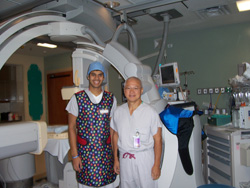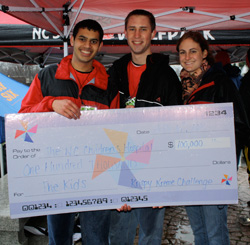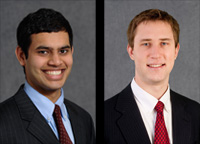Park graduates Sudeep Sunthankar ‘12 and John Yanik ‘12, along with four collaborators, recently published a patent on “Implantation tools for spinal cord stimulator leads and related methods” – affectionately known by the U.S. Patent and Trademark Office as US 20130289685 A1.
This now-patented device was the focus of Sunthankar’s and Yanik’s senior design project for the Department of Biomedical Engineering. Their goal was to aid neurosurgeons in implanting spinal cord stimulator leads, which is a common procedure for patients whose chronic pain is no longer responsive to medication. Currently, the technique for implantation can be quite difficult as it requires the surgeon to access the spinal cord through a narrow window in the back. The surgeon must remove portions of a vertebra to expose the underlying neural tissue before guiding an electrical lead up the spinal cord to a pre-determined location.
The device Sunthankar and Yanik helped develop makes use of a novel grip-and-release system which affords the surgeon more control over the lead during insertion. It also offers the ability to adjust the lead’s position at a distance without removing and reinserting the entire apparatus, as is currently done.
Sunthankar and Yanik, who’d always enjoyed studying science and mathematics, earned undergraduate degrees in biomedical engineering from NC State. Upon graduation, both entered medical school – Sunthankar at the Medical University of South Carolina in Charleston, S.C., and Yanik at Wake Forest University School of Medicine in Winston-Salem, N.C.

Yanik said it was not until his senior year in college that he considered medicine as an alternative to a more traditional engineering career. Sunthankar, however, realized his interest in medicine early on, sparked by a MIT Media Lab science fair presentation about prosthetic development.
Sunthankar is interested in pediatrics with subspecialties in cardiology, oncology, or general practice. He says one of the reasons he has such an interest in pediatrics is because of the Brody-Park internship, which he completed during the summer of 2010. Through this experience he spent five weeks shadowing and observing various pediatric fields at East Carolina University’s Brody School of Medicine. Sunthankar was among the first of several Park Scholars to pursue this internship. (Check out the 2011 and 2013 Brody-Park interns.)
When asked how his engineering major lends itself to his current studies, Sunthankar said, “Having an engineering background in medical school has shaped the way I study and integrate information and also provides a slightly different perspective when analyzing problems than the traditional science backgrounds.”
Academics weren’t the only aspect of Yanik’s undergraduate career that afforded him sound preparation for his current pursuits. While one might not expect to draw connections between a donut-themed event and medical school, Yanik cited the Krispy Kreme Challenge as a key skills-builder.

“Working with such a large number of committee members to plan and execute the event gave me a taste of the professionalism, teamwork, and cooperation that is necessary, not only within the medical profession, but in any career,” said Yanik, who served as co-chair of the 2011 Krispy Kreme Challenge alongside Sunthankar and Park classmate Rachel Turner ‘12.
Likewise, Sunthankar said he has never poured so much effort into a single project and felt so overwhelmingly rewarded from the outcome as he did leading the Krispy Kreme Challenge, which raised $122,000 for the North Carolina Children’s Hospital that year alone.
Perhaps someday Sunthankar and Yanik will be among the physicians whose young patients benefit from the Krispy Kreme Challenge’s proceeds – only time will tell.
Story by Laura Turner
posted 2014.06.06
